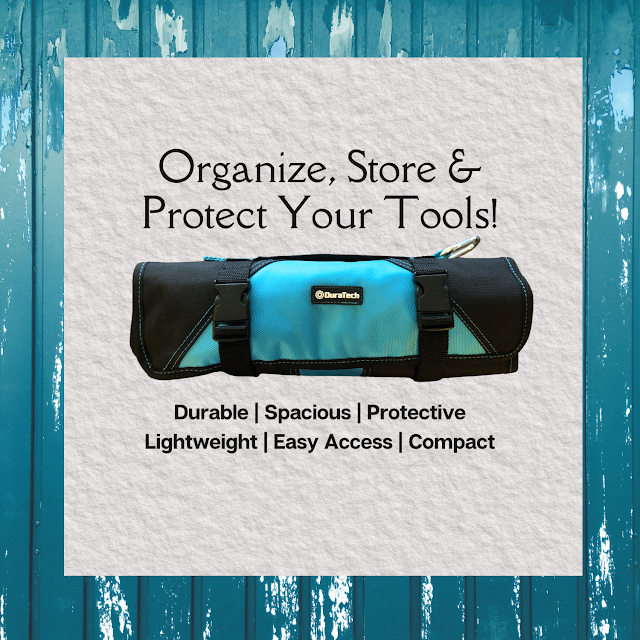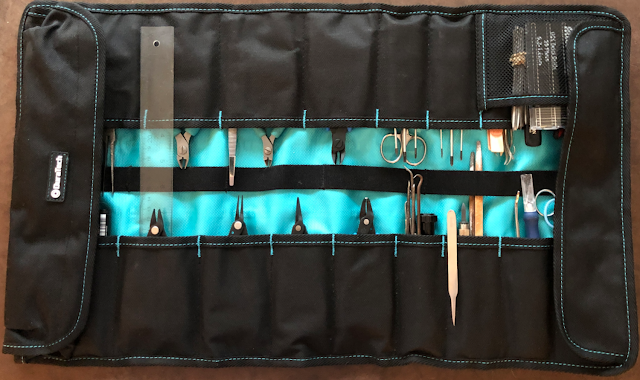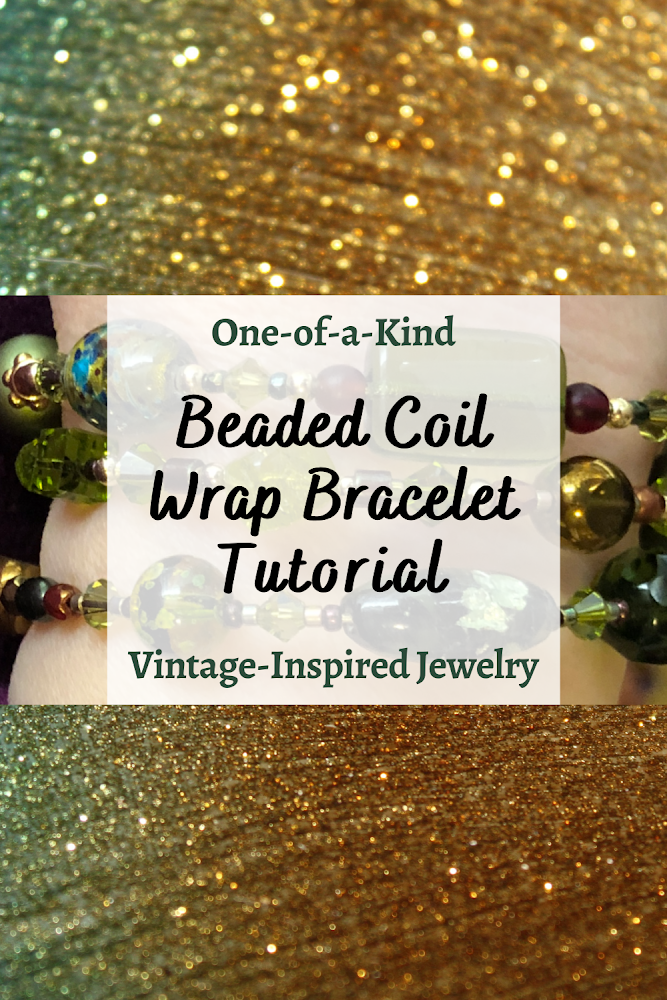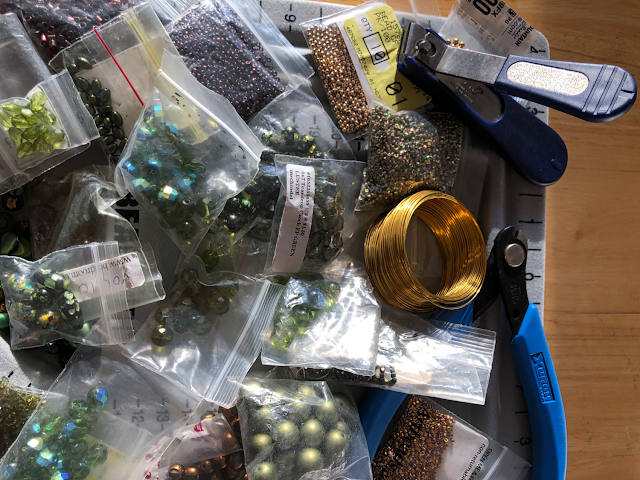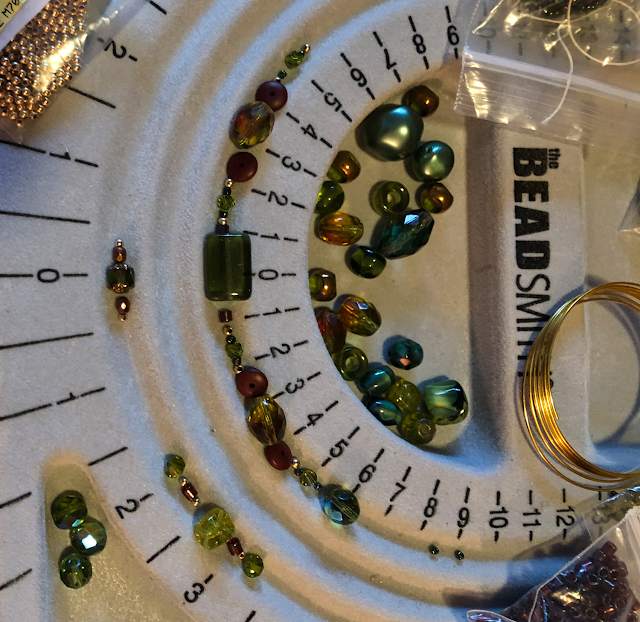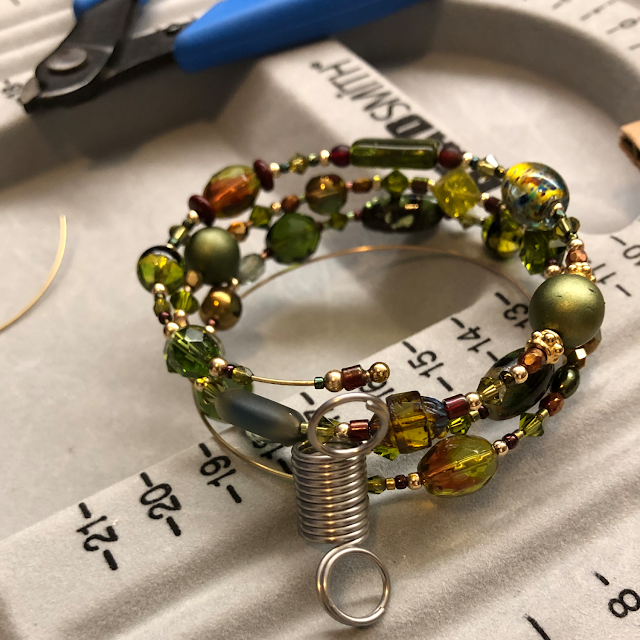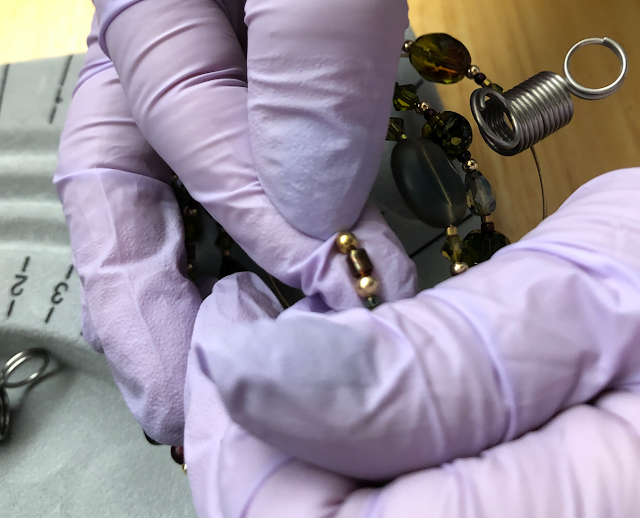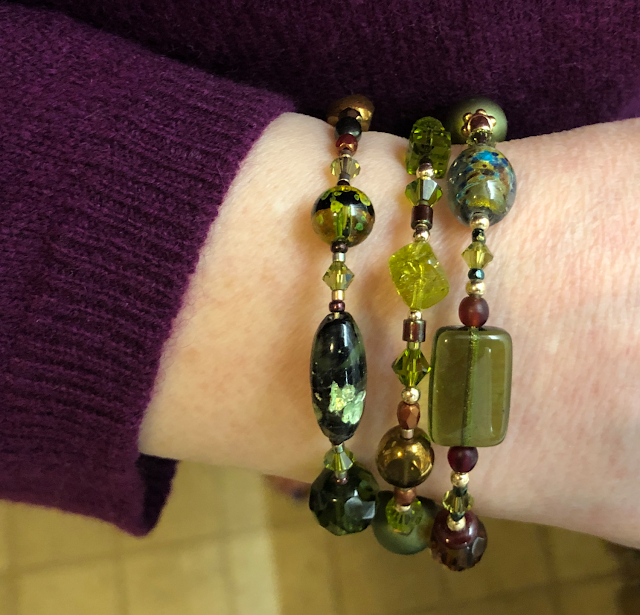Whether you enjoy jewelry making, building, painting or refurbishing models, other hobby, crafts & DIY projects or doing small electronics repairs, investing in good quality tools for doing delicate precision work can help achieve better results faster and with less effort by giving you more precise control and leverage while reducing the strain on your hands (your most valuable tools by far!).
Choosing the right tool storage and organization system can not only help protect that investment but also enhance your efficiency and enjoyment of the creative process while you are working on your projects. However, I have learned the hard way how challenging it can be to evaluate, compare and, ultimately, determine the best solution for your individual tool storage and organization needs,
Today, I am sharing my personal product review of the DuraTech Tool Roll Organizer, 21 Pockets Tool Bag Roll that I bought a few months ago as a Christmas gift for my husband, who has an extensive collection of precision hand tools for his hobbies, crafts nd DIY projects.
My husband John works long hours at a rewarding but stressful and high-pressure job. One of his favorite ways to relax and recharge his batteries is working on a variety of hobby, crafts & DIY projects. He especially enjoys collecting and restoring rare and hard-to-find, vintage 1:43 scale die-cast model cars and trucks, as well as collecting and refining hard-to-find plaster buildings for our Christmas village display and then painting them in stunning, elaborate detail and adding interior lights. Sometimes, he even adds strategically placed, tiny color-changing LEDs to create special effects (for example, randomly flashing multicolored lights inside a Harry Potter-esque magic shop, as though the wizards inside are trying out different magic wands to find the one that will choose him or her, or simulating the glow of a blacksmith's forge by carving out a large, wide opening in a wall, lining it with iridescent, colored foil through which you can see tiny LEDs, each cycling through red, orange and yellow and out of sync with each other). We actually display two different Christmas villages, one made up of lighted Dept. 56 Christmas in the City buildings and another with John's amazing carved, exquisitely painted and lighted plaster buildings. During the holidays, our display can take up half of our living room, with two villages arranged around that year's train tracks layout and connected by John's wonderful, vintage, O-scale model train collection, some of which he inherited from his beloved uncle.
Since John isn't easy to buy gifts for, I usually ask him for a Christmas wish list to give me some guidance. (I also choose one or two gifts for him that will be complete surprises, but in case they miss the mark, I know that he'll at least get some of the gifts he really wants!) Two of the items on his most recent wish list were a set of good quality, upgraded pliers and cutters and a better storage and organization solution for them and the rest of his precision hobby tools.
Since I used many of the same items as jewelry making tools, I knew exactly which pliers and cutters I wanted to buy for him. Xuron makes very high quality tools for small-scale, delicate, precision work at a very reasonable price. They are also more durable than similar tools I have purchased from much more expensive brands. So I chose several pairs of my favorite Xuron pliers and cutters as part of John's Christmas gift.
However, while there are lots of great toolboxes and other tool storage and organization options for larger tools, like hammers, wrenches and sockets, I knew that finding a better tool storage and organization solution for my husband that would meet his specific requirements would be a lot more challenging, since he had already experimented with several different types of tool organizers and storage that weren't working for him.
Great Tool Storage and Organization Solutions for Precision Pliers, Model Building Tools, Jewelry Making Tools, Etc. Are Surprisingly Hard to Find!
Last year, John purchased a secondhand, wheeled O.P.I. nail polish salesperson's sample case that he has been converting into a super cool, customized, mobile crafting workstation with a spacious, attached, removable work surface that he calls his hobby tray. Since he doesn't have a dedicated workspace for his hobbies and crafts, this clever solution now enables him to work on crafts and DIY projects whenever he has a bit of time, wherever he happens to be. Even better, it also doubles as a compact, consolidated storage organizer for all his painted plaster Christmas village, electronics repair and vintage die-cast car refurbishing and model building tools, supplies and current projects.
He has been having a blast "imagineering" (to use a Disney term) and tweaking his one-of-a-kind mobile craft storage and workstation over time. In fact, redesigning and refining has turned out to be one of his favorite projects to date!
He had come up with workable solutions for customizing the interior in terms of organizing and storing his paintbrushes, paints, glues, sandpaper, markers and other supplies and for safely storing delicate project works-in-progress. Unfortunately, he wanted (and needed) a better way to store and organize a variety of other tools, including pliers and cutters, needle files, riffler files, X-ACTO knives and blades, hemostats, dental picks, micro carving tools, tweezers, specialty pens, scissors, miniature screwdrivers, a ruler, a pin vise, micro drill bits, etc.
These precision tools needed to be easily visible and acccessible while in use and protected during storage and transport, and the tool organizer not only would need to fit neatly inside the top compartment of the new mobile hobby storage/workstation but also work as a standalone, portable tool storage organizer that he could easily bring to another location, for example, to help a friend or family member with an electronics or jewelry repair project.
In addition, John's ideal tool organizer and storage solution would need to hold a lot of tools, in a wide range of shapes and sizes, and store them compactly, as well as be both lightweight, sturdy and wear-resistant.
Traditional and Nontraditional Tool Organizers Didn't Meet Our Needs
Like John, I have been a "maker" since I was a child. and have spent many years trying to find better storage and organizing solutions for my jewelry making, beading, metal clay, polymer clay and painting tools and supplies. While I discovered some wonderful bead storage and organization solutions years ago for my enormous collection of rare and vintage beads and jewelry making supplies, I continue to search for better jewelry making tool storage and organization solutions.
Between the two of us, we have tried or considered a variety of traditional hobby, DIY and craft tool holders and organizers, such as brush holders, tool caddies, plier stands and tackle boxes. (Plano tackle box systems are wonderful for storing jewelry findings, beads, and other jewelry making supplies, but not the best solution for storing, organizing and protecting delicate precision tools.)
We both have also tried a number of non-traditional tool storage and organization solutions, such as cosmetics organizers, including the acrylic eye pencil and lip pencil organizers and lipstick/lip gloss organizer that I keep on my vanity for makeup. (They work great for their intended use!)
Unfortunately, every commercial or DIY tool organizer solution either of us has tried over the years has had significant limitations that failed to meet our respective precision tool storage and organization needs. As a result, each of us ended up having to cobble together several different tool storage and organization products to accommodate our collections.
Some of the Tool Storage and Organizer Products We Tried That Missed the Mark (and Why)
- Storing delicate, precision tools in a Plano tackle box rack system would give them no protection. They would rub against each other, potentially nicking or dulling cutter blades or scratching or dinging smooth pliers jaws, creating uneven surfaces that would transfer to the wire or metal on which they were used.
- For example, John's coarse bastard file or diamond-coated riffler files could wreak havoc on his pair of fine nippers if they were to come into contact.
- Another important downside of that type of storage is that it would not be easy to see each individual tool at a glance and find and remove the desired one quickly and easily.
- Tool storage organizers with uniform-size compartments, like brush holders or marker storage units, would not work for pliers, cutters or similarly shaped tools. Even straight tools of varying widths, lengths/heights and diameters could not be stored and organized in these storage solutions efficiently (and some tools were too wide or thick to fit at all.
- None of the three common types of pliers storage solutions I have used have been particularly convenient for me, and none would work for John's mobile hobby and crafts cart.
A pliers rack is fine if you have a permanent spot for it to live in a dedicated workspace. However, they don't protect the tips of the pliers, cutters or nippers from each other and would be unsuitable to lay on their sides in John's rolling hobby station cart.
Wood pliers blocks keep the pliers and cutters separated and, therefore, somewhat protected. However, they don't fit every pair of pliers or cutters (especially those with wider/ergonomic handles or grips), and removing and replacing the tools into the holes in the block requires a bit more fiddling than we want to do, especially for the pairs in the middle of the block.
I have a lot of jewelry making pliers and cutters, most of which I have been storing in zippered tool pouches (similar to this Eurotool tool pouch with zipper), for lack of a better lightweight, easily portable solution. They have elastic loops or straps inside to hold the tools in place and prevent them from knocking into each other when not in use. Unfortunately, since the manufacturer doesn't know the sizes, shapes, handle widths and other characteristics of the pliers and cutters you own or how many you have, I have found that unless the zipppered tool case was designed by the manufacturer for a specific brand and set of these tools, it is very difficult to use the interior storage space efficiently.
More importantly, in my experience, it is impossible to remove a pair of pliers or cutters from the elasticized loops without using two hands, even if the tool pouch was custom designed by (or for) the tool manufacturer to work with a specific set of pliers and cutters from a single product line, and especially if the tips have protective caps. So, whenever you are working on a project and need one of those tools, you have to stop working, put down the project so you have both hands free, and then wiggle and coax the required pair of pliers or cutters out from under their elastic strap restraints (without banging into or dislodging any adjacent pairs) before you can pick up the project again with your nondomiant hand and try to pick up where you left off before this unnecessary and distracting interruption.
The need for a simpler, more compact, more portable tool storage solution became a much higher priority when John began customizing his new mobile hobby workstation. (Since we have also been rethinking and trying to redesign my too-small crafts room/ "studio" space, if I could figure out a great tool storage and organization solution for John, I had my fingers crossed that maybe it could work for my jewelry making and crafting tools, too!)
The DuraTech 21-Pocket Tool Roll Organizer to the Rescue
One Tool Organizer and Storage Solution to Rule (and Hold and Protect) Them All!
As usual for me when shopping for an important product purchase, I did my due diligence.
I began with an in-depth needs analysis, asking John to describe in detail his storage and organization requirements for his model building tools and to take me through all the types of craft storage he had already tried and explain why they didn't do what he wanted and needed.
Then, armed with that information (and a spinning head!), I dove into my product research. Since I had already been looking for solutions to similar storage and organization challenges for my jewelry making tools for my compact crafts studio redesign, I was already familiar with a lot of what was out there and knew that none of what I had found so far would meet my husband's very specific needs.
Fortunately, my persistence paid off! I wanted to make sure that whatever tool storage and organization solution I picked for John would be one he would be happy with, so I had decided to run my choice by him before ordering it, rather than keeping it a surprise until he opened it with his other Christmas gifts.
When I showed him the DuraTech Tool Roll Organizer, 21 Pockets Tool Bag Roll I had picked out for him on Amazon, I could telll immediately from his interest that I was on the right track. The more he read, looked at the product photos and read the product reviews, the more his eyes lit up.
I placed the order that same day, fingers crossed that he would love his new DuraTech tool roll organizer as much when he put his gift to use after Christmas as he did when looking at the product page. Fortunately, he did!
Key Features and Benefits
After filling his new tool organizer with his scale model making tools and using his DuraTech 21-pocket tool roll organizer for more than a month, here are the things he loves about his gift.

|
| Areas of stress are reinforced with bartack stitching between the pockets and heavy-duty, stitched twill tape bias binding enclosing the edges of the pockets and flaps. . |
Durable Premium Fabric, High Quality Construction
- The double-layer, high-quality, waterproof 1680-denier turquoise blue and 900-denier black oxford cloth fabrics are extremely durable, making this Dura-Tech tool roll organizer both sturdy and water-resistant. (Oxford cloth is a tight basketweave fabric. The ones used in this tool roll appear to be ballistic coated nylon or polyester oxford cloth, similar to Cordura fabric.)
- Even if you aren't storing your tools in a car or shed or traveling with them, so they are exposed to the elements, it's still nice to know that they will be protected against spills and water damage in the event of an accident.
- The comfortable haul handle, adjustable straps, buckles and hook-and-loop flap closure are also made of sturdy, high-quality materials with durable construction, e.g.:
- bartack stitching reinforcement between the pockets and on the top haul handle, areas most likely to be subject to stress during use.
- edges of the pockets and flaps are bound with heavy-duty twill tape bias binding tape and stitched securely with sturdy contrasting thread.
- After two months of nearly nonstop use, my husband’s DuraTech 21-pocket tool roll organizer still looks brand new.
Thoughtful and Attractive Design
Pockets Galore
- The 17 main pockets that span the length of the tool roll's interior along both sides are tall and come in different widths. The wider pockets can accommodate and hold most pliers and cutters securely to prevent them from moving around and potentially causing damage to the working surfaces. The narrower pockets are great for storing thinner tools and can even accommodate a 12-inch ruler, as you can see in the photos of my husband's DuraTech 21-pocket tool roll organizer.
- The three shorter, deeper, gusseted pockets at one end can hold a surprising amount, and there is a flap with a hook-and-loop tape closure to help keep the contents from escaping accidentally. These are great for storing smaller items (e.g., a set of micro drill bits housed in a hard storage case, a set of sockets, small packages of nails, screws or washers, a tape measure).
- At the opposite end, there is also a sturdy mesh pocket attached to the outside of one of the 17 main pockets. Since this mesh pocket is shorter and also see-through, it's perfect for shorter tools, such as needle files, that could slide down inside one of the taller, opaque, main pockets, where they would be hidden and hard to reach.
- The DuraTech tool roll organizer lays flat when unrolled and filled with tools, and there’s plenty of room in each pocket. This means you not only can store all your crafting, model building or jewelry making tools in one place and see them all at a glance, you can also easily remove and replace each tool with just one hand while you are working, so you don't have to put down your project every time you need to reach for a new tool.
 |
| The open mesh pocket at one end of my husband's DuraTech Tool Roll Organizer holds micro drill bits (in a fitted case), needle files and a small diamond nail file for rounding and smoothing wire ends |
Striking Use of Contrasting Colors Goes Beyond Just Good Looks
- The two-tone black and bright turquoise color-blocked design looks very sharp and distinctive. Bonus—the bright blue color makes it easy to spot your tool storage organizer quickly if you happen to misplace it (or if your work space, craft room or studio is messy and overcrowded, like mine).
- The "business end" of the tool(s) in each stitched pocket are much more visible against the backdrop of the bright turquoise fabric lining in the center. So, you can quickly and easily distinguish a pair of round-nose pliers from a matching pair of needle-nose pliers or a Phillips-head from a flathead mini screwdriver, or pick out an individual diamond-coated riffler file from others in an assorted set.
Versatile Touches
- The large, sturdy, aluminum D-ring next to the haul handle can be used to hang your DuraTech tool roll organizer from a hook or to use as a keyring, attach a water bottle, etc.
Capacious When in Use, Lightweight and Compact When Rolled up for Storage
- The DuraTech 21-pocket tool roll organizer can hold a lot of pliers, cutters and other hand tools.
- The adjustable straps allow this tool roll organizer to accommodate a large number of tools of varying shapes and sizes and store them securely. In fact, if you shake the closed and buckled tool roll, you won't hear any of the tools rattling against each other.
- As you can see, even after my husband put all his favorite model making, crafts and DIY and other hobby tools into his new DuraTech tool roll organizer, there is still plenty of storage room for future specialty pliers or other precision tool acquisitions. (As any hobby or crafting enthusiast will tell you, you can never have too many tools, lol!)
- Given its generous capacity, this tool roll is surprisingly lightweight and compact. It's takes up relatively little real estate on a work surface or in a cabinet, drawer or rolling cart and doesn't add much weight to that of its contents, making it extremely portable.
A Remarkable Value
- After researching so many tool organizers and storage solutions, I was very surprised (and delighted) to discover how affordable this DuraTech tool roll organizer is, given its obviously superior quality materials, construction, design and durability compared to most of the other types of storage and organization products I've found during my extensive searches.
- Currently this DuraTech 21-pocket tool roll organizer is priced at less than $18 on Amazon, which I consider an absolute steal in terms of value for money.
A Inexpensive and Thoughtful Gift for Any Jewelry Making, Scale Model Making, Electronics or DIY Enthusiast
My husband couldn't be more thrilled with his DuraTech 21-pocket tool roll organizer. I'm seriously considering buying another for my jewelry making pliers, cutters, awls and other hand tools.
It's hard to imagine anyone whose hobbies and interests include model railroading, remote-control cars and planes, building scale models or dioramas, jewelry making, watch repair, electronics and similar creative pursuits who wouldn't appreciate receiving such an attractive, thoughtfully designed, well made and durable storage organizer for their precision tools as a gift.
Of course, if that description also fits you, I encourage you to consider treating yourself to one of these terrific DuraTech tool roll organizers.


